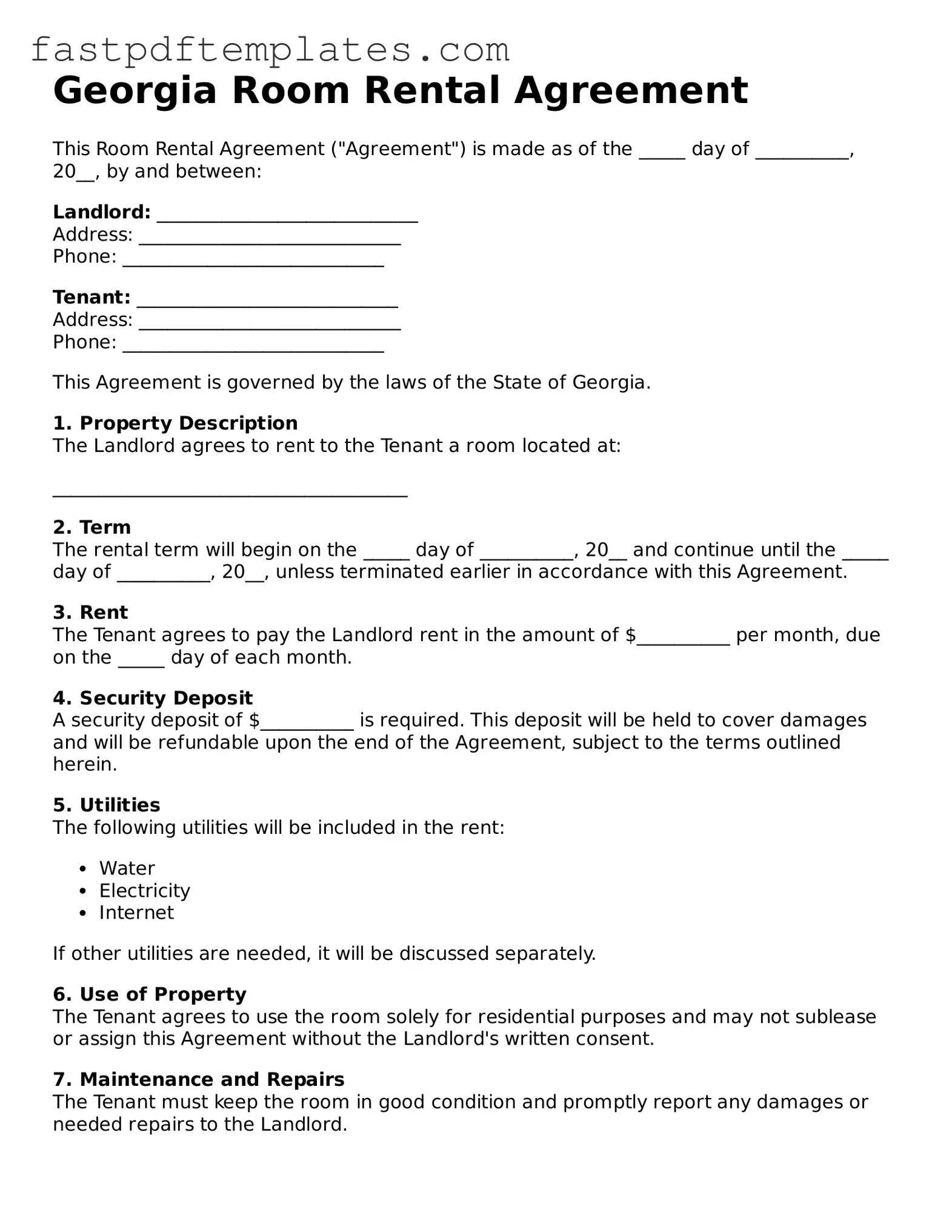The Georgia Room Rental Agreement is similar to a standard Lease Agreement, which outlines the terms between a landlord and tenant for renting a property. Both documents specify the rental amount, duration of the tenancy, and responsibilities of each party. While a Lease Agreement typically covers entire properties, the Room Rental Agreement focuses specifically on individual rooms within a shared living situation, making it ideal for roommates or subletting scenarios.
Another document that shares similarities is the Sublease Agreement. This form is used when a tenant rents out their leased space to another individual, often for a portion of the original lease term. Like the Room Rental Agreement, it details the rent amount and terms of occupancy, but it also requires the original tenant to maintain responsibility for the lease with the landlord. Both agreements must clearly outline the expectations and rules for the subtenant.
The Roommate Agreement is also akin to the Georgia Room Rental Agreement. This document is designed for individuals sharing living space but may not involve a formal rental arrangement. It establishes guidelines for shared expenses, chores, and other living conditions. While the Room Rental Agreement is more legally binding, the Roommate Agreement focuses on interpersonal relationships and mutual respect among roommates.
A House Rental Agreement can be compared as well, as it covers the rental of an entire house, similar to how the Room Rental Agreement covers individual rooms. Both documents stipulate the rental price, security deposit, and maintenance responsibilities. However, the House Rental Agreement usually addresses the entire property, while the Room Rental Agreement is more specific to room-sharing situations.
The Vacation Rental Agreement is another similar document. This type of agreement is used for short-term rentals, often for vacation homes or rentals through platforms like Airbnb. Like the Room Rental Agreement, it includes terms regarding payment, duration of stay, and rules for the property. However, the Vacation Rental Agreement typically has a more flexible timeframe and may include additional clauses for cleaning fees or security deposits specific to short stays.
The Commercial Lease Agreement shares some similarities as well, especially in how it outlines the terms of renting a space. This document is used for business premises and details the rent, duration, and responsibilities of the tenant and landlord. While the Georgia Room Rental Agreement focuses on residential living, both agreements require clarity on terms to avoid disputes and ensure a smooth rental experience.
The Rental Application Form is another document that complements the Room Rental Agreement. This form is filled out by prospective tenants and gathers essential information such as employment history, references, and credit checks. While it does not outline rental terms, it serves as a preliminary step to ensure that the landlord finds a suitable tenant, which ultimately leads to the signing of the Room Rental Agreement.
The Tenant Rights and Responsibilities document is similar in that it educates tenants about their legal rights and obligations. While the Room Rental Agreement specifies the terms of a specific rental situation, this document provides a broader overview of what tenants can expect in any rental scenario, including issues like security deposits, repairs, and eviction processes.
The Rental Termination Notice is also relevant. This document is used by either party to formally end a rental agreement. It outlines the necessary notice period and the conditions under which the agreement can be terminated. Like the Room Rental Agreement, it emphasizes the importance of clear communication and adherence to established timelines to prevent misunderstandings.
Lastly, the Move-In/Move-Out Checklist is another document that complements the Room Rental Agreement. This checklist is used to document the condition of the property at the beginning and end of a tenancy. It protects both the landlord and tenant by providing a clear record of any damages or issues, ensuring that both parties are on the same page regarding the condition of the rental space.
